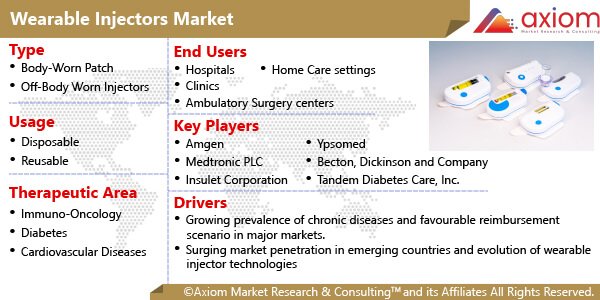Wearable injectors are delivery systems that adhere to the body to administer larger volumes (more than 2 mL) of drug subcutaneously over an extended period. While there is variability amongst products, all wearable injectors provide a reservoir for the medication, a cannula for delivery to the tissue, adhesive to fix the device to the patient’s skin, and a drive system to deliver the appropriate drug volume. Wearable injectors effectively address the volume and viscosity challenges of prefilled syringes and auto-injectors, allowing highly-concentrated drugs to be diluted into larger volumes and administered over longer periods without saturating the SC space. Although the potential benefits of these delivery systems are numerous, perhaps the most notable is the ability to self-administer high-volume, high-viscosity drugs in a non-clinical setting.
Wearable Injectors Market Outlook
Wearable injectors represent a new and innovative sector within the injectable drug delivery market. They provide the opportunity to deliver large volumes of drugs subcutaneously together with the many associated benefits to drug developers, clinicians and patients. The global wearable injectors market is witnessing significant growth owing to growing prevalence of chronic diseases and favourable reimbursement scenario in major markets. Furthermore, surging market penetration in emerging countries and evolution of wearable injector technologies would further provide significant growth opportunities to this market. The size of the market opportunity for wearable injectors is also driven by surging devices to deliver drugs for cancer and related conditions. In addition to offering improved therapies, pharma companies have the potential for new branding opportunities and improved lifecycle management. Many pharma and biotech companies are currently seeking out wearable delivery systems and platform partners. However, the market is hampered by preference for alternative drug delivery modes.
Wearable Injectors Market Segmental Overview
The report analyses the global wearable injectors market based on type, usage, therapeutic area, end user and geography.
Wearable Injectors Market by Type
Based on type, the market is categorized into body-worn patch injectors and off-body worn injectors. Body-worn patch injectors use an adhesive to connect the device directly with the patient’s skin. Depending on the size of the device, this adhesive area can reach that of a face of a mobile phone.
Wearable Injectors Market by Usage
Based on usage, the market is categorized into disposable and reusable wearable injectors. Enable Injections is a late-stage start-up company that has developed a disposable on-body injector to deliver high volume (up to 50 mL), high-viscosity drug/biological products to the subcutaneous tissue. The system utilises standard container closures (syringes or vials) and can automatically mix solutions or solubilise lyophilised product.
Wearable Injectors Market by Therapeutic Area
The wearable injectors are applicable in various therapeutic areas such as immuno-oncology, diabetes, cardiovascular diseases, other therapies such as Parkinson’s disease, thalassemia, and primary immunodeficiency disorders. The wearable injectors are now regularly self-administered subcutaneously to treat chronic diseases such as rheumatoid arthritis, multiple sclerosis and dyslipidaemia, among others. They can accommodate new formulations with higher volume and/or viscosity enabling less frequent injections and potentially increasing adherence to therapies.
Wearable Injectors Market by End Users
Several end users of this market are hospitals, clinics, home care settings and ambulatory surgery centers. Wearable injectors present a comprehensive solution to the challenge of delivering SC injections of increasing dosing volumes and viscosities in non-clinical settings. Introducing robust, innovative technologies will allow more patients to enjoy the convenience of injecting at home.
Wearable Injectors Market by Geography
By geography, the global wearable injectors market is studied across the countries of key regions such as, North America, Europe, Asia Pacific and rest of the world regions which includes Latin America, and Middle East & Africa. North America accounted for the market largest share in 2018. Availability of supportive government policies for the development of advanced wearable injectors technologies is the key growth drivers of this market in this region. Moreover, the Asia Pacific is expected to show lucrative growth during the forecast period due to rising prevalence of chronic diseases such as cancer, diabetes, and cardiovascular diseases coupled with favourable reimbursement scenario.
Wearable Injectors Market Key Players
The leading market players of the global wearable injectors market are Amgen, Medtronic PLC, Insulet Corporation, Ypsomed, Becton, Dickinson and Company (BD), Tandem Diabetes Care, Inc., United Therapeutics Corporation, Valeritas, Inc., Enable Injections, Steadymed Therapeutics and Sensile Medical (Gerresheimer). BD Libertas represents the newest addition to BD’s platform of integrated device components to support the development of combination products to enable a variety of options for delivering self-administered biologics.











